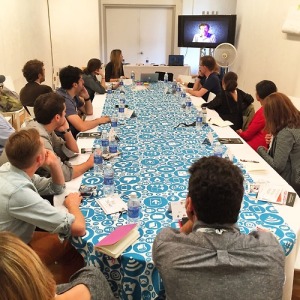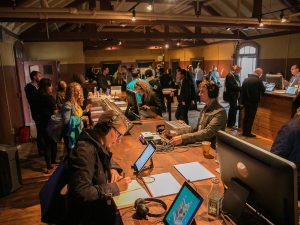

A few years ago, Charlie Melcher was a successful book publisher who realized his industry was being swept away. So he invited the best storytellers, technical experts and brandmakers to a roundtable discussion about the future of storytelling, in order to embrace whatever was coming next. He asked the group: what are the most radical tools available? Tell me how amazing it could be.
Three years later, that roundtable meeting has swelled into an annual, invite-only festival known as The Future of Storytelling Summit. Unlike a regular conference, where participants listen while colleagues present at a lectern, the event is a collection of discussions and workshops, where experts as diverse as Robert Wong (Google Creative Lab) and Monica Bill Barnes (dancer) lead sessions on new approaches to storytelling.
This year, the event was held in Snug Harbor, on Staten Island, on October 1 and 2. Did it reveal how stories will change in the future? Kinda.
It was the most well-organized and expensive conference I’ve ever attended. Each room in the heritage site was a pavilion of ideas, so something novel was always around the corner. But even though I’m collaborating on a story-based intelligence system, I was disappointed at the emphasis on media. Given the topic, I craved an exploration of the new spaces that can be made within stories themselves. Even so, there was much to learn about the future of wearing and sharing stories. Over the next few years, I predict that innovative storytelling will feature one or more of the following qualities:
It will be presented on a new kind of machine. Conference organizer, Charlie Melcher, said he wanted to present tools that extended the five senses. Among the featured experts was a perfumer, an architect and a magician, plus a buffet of perception enhancers (Oculus Rift, Google Glass, oPhone, Binauric speakers). Not many of the gadgets presented new kinds of narrative – not yet. At the moment, this boom of technological devices is simply a way to involve more than one of your senses in the consumption of information, or to connect with another person more easily. Currently, only a few researchers have figured out how to integrate these into anything more than a puff of experience, or an advertisement.
Possibilities could be glimpsed, however. The oPhone (odor phone) holds two cartridges that contain 36 basic scents, from which a range of more sophisticated aromas can be composed. A tap of your iPad can release the aroma of cut grass or Paris in 1736. I smelled lavender wafting from the nozzle, so can confirm that it works. A participant cognitive scientist pointed out some problems with odor being used in storytelling: a sequence of scents will confuse the nose because they ‘pollute’ each other; also, coding a site with odor requires some understanding of perfumery. Inventors David Edwards and Rachel Field explained that it could be used to sell cookbooks online which seemed like a reduction of potential.
Besides scent, sound was also well-represented. A new kind of speaker, Binauric, allowed sound to be recorded in 360 degrees, the aural equivalent of surround camerawork. Neil Harbisson, a human cyborg (his face was projected onto a robotic body) showed a movie in which colours were perceived as different musical notes. Later that evening, Violinist Tim Fain played Tchaickovsky’s dying swan while a lattice of LED lights blinked in sympathy behind him. In general, however, not many of these initial attempts at harnessing multi-sensory stimulation managed to produce a story that outshone the novelty of their media.
An exception was Nonny de la Pena’s Project Syria, a virtual reality installation that transports viewers into news events, such as the bombing of Aleppo, Syria. This technology could indeed alter how news stories are digested. If I had to regularly sit within the massacres of Rwanda, would I retreat from being updated? Or would it change the way I related to them? Chris Plutte, of the Global Nomads Group, arranges events that assume the latter. He arranges video conferences between child survivors of the Rwandan genocide and schoolchildren from first-world countries like the United States, in order to turn news into a human reality.
Viewing these two projects, it became clear how much mastery is needed to handle powerful personal narratives. Perhaps to address this, the summit also featured storytellers from traditional art forms – film-makers, writers and actors. These experts did serve narrative punch, but strangely, when their work was expressed in new media, the work often accrued an old-fashioned vibe. After viewing numerous examples of these artifacts, I started to figure out why.
It will make you ache, but you’ve probably heard it before. Take a look at Seeds by Aneesh Chaganty, one of this year’s FoST fellows. It was shot entirely on the wearable Google Glass, and won Chaganty a position in Google’s Creative Lab 5 program, where select creatives are paid to imagine new products. Besides being beautifully crafted, Seeds is also an example of the kind of stories that are successful on social media and viral advertising. It is good at catching your attention but not designed to confront you. It changes what you like, rather than changing your perspective.
After being shown examples of other popular videos, one attendee finally commented that there were too many babies in the summit. And puppies. And kids in hospital. Robin Wood from Unruly, who specializes in helping ads go viral, says this sort of touchy-feely content is the key to ensuring that people will pass it forward. Humor is culturally specific and can fall flat or worse. On the other hand, a story that delivers warm fuzzies can be embraced by the entire spectrum of people who might buy Budweisser. Ads need to be accessible, which can sometimes conflict with the aspect of stories that makes them arresting or valuable in the long-term. In spite of this, it was clear that advertising is driving much of the commercial development of new storytelling forms.
It will be an advertisement. Many of the 500 FoST participants were ad people. Massive corporations (Pepsico, Chanel, P&G, Hewlett-Packard, Fisher Price) sent their best marketeers to discover what tricks or trends could get their products noticed. Most of the walking tours on the second day took us to agencies that made campaigns for companies larger than governments. Some of the most interesting examples of new techniques emerged from this hotbed of dollars and vested interest. The best had features that overlapped with performance art.
It will resemble performance art. The most daring agencies used smart gear and elegant design to change social relationships. For Coca-Cola, ad company Fake Love set up special Coke machines in four international cities: Buenos Aires, Cape Town, New York and Milan. What was special about those vending machines? They wouldn’t allow you to buy a Coke for yourself. Instead you could only purchase one for someone on another continent. Cameras allowed you to see them, or record a message for them. Apparently there were queues around the block to experience this soda chivalry.
Similarly unique was the promotion of Nine Inch Nails by 42 Entertainment, which left unmarked thumb drives containing an unreleased Nine Inch Nails song around one of the concert venues. A fan found one in a bathroom, realized that he might be in possession of an unreleased single from his favorite band, and uploaded the song to an online NIN community, which then tried to verify it. This novel form of release got a lot of attention, because it was a way cool story. Which is what everyone wants. And that brings us to:
It will be digested by social media. The curation of social media has become an industry. The summit introduced us to some of the companies that can do it for you, such as Unruly (mentioned above) and Everybody at Once (Ea1). Ea1 find online communities, organize groups for them to join, and offer them incentives to hang out there. They emphasized that a social interaction is human, like a conversation, rather than commercial, like showing an advertisement to a crowd. Spamming with one-way promotions was likened to throwing a dead cat over a village wall. But what can be offered instead?
Content, came the reply. (Kevin Spacey makes some interesting observations about content in another forum). But what makes content valuable? A few roundtable leaders had stand-out insights on content and storytelling, and they deserve a category of their own. In terms of social narrative, good content seemed to have a philosophical edge.
It will have a philosophical edge. Design expert John Maeda conducted a session that came to be considered the zen koan of workshops. Maeda asked each person in his group to share three stories: their favorite color, something that made them vulnerable, and finally, what they had learned from each other. As everyone’s rawness tumbled into the forum, the session became moving, engaging and instructive. One participant emerged awestruck that Maeda had only spoken three sentences during the session and somehow “changed the structure of his brain.”
In a similar way, Punchdrunk theatre director Felix Barrett blends performance with real-world situations, shifting ordinary spaces through narrative triggers. In a video explanation, he gives an example: his audience are told to catch a train to another station, where they will be met by the next performer. He describes how, when participants get off the carriage, the station comes alive, as every ordinary commuter becomes a potential agent of interaction.
These artists stood out, for the way they changed spaces, and in the process, altered social potential. For me, narrative involves this idea of transformation, much like the artificial intelligence definition of computational creativity, where diverse situations interact until new merger is found (scientist Margaret Boden said it first). This process was made visible in the work of architect Bjarke Ingels from Big, who showed the numerous stages of design for a watchmaking museum in Switzerland. As he flipped through twenty possible forms [see minute 15:05 in this video], we saw how landscape, client requirements and the notion of watchmaking itself wrestled until the ideal shape was found.
At the FoST summit, most participants fell somewhere on the spectrum leading to that final new form, without reaching it. Engineers offered novel technologies to facilitate connections, traditional artists showed how resonant the result should be, social experts figured out how to get people talking about it and brandmakers looked for ways to capitalize. Yet only a few gathered all aspects into new forms of the art, making spaces that were truly surprising, and drawing out new selves to inhabit them.